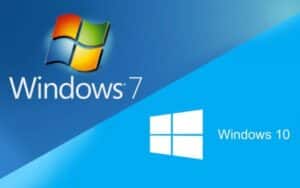 So you’ve left it to the last minute! You know Windows 7 is being retired, but you’ve done nothing about it, and you want to know what your options are, well you’re in the right place.
So you’ve left it to the last minute! You know Windows 7 is being retired, but you’ve done nothing about it, and you want to know what your options are, well you’re in the right place.
Read Microsoft’s official announcement here, but we’d much rather you stay and read ours. It’s much nicer.
Microsoft’s official statement does not provide a great deal of information so let’s go through, explain and see what this means for you. It should also be noted, that it’s not only Windows 7 that is being put to pasture, but any servers running Windows Server 2008 will also be for the chop, as they are based on the same code. So anything we’re saying here about Windows 7, also applies to Server 2008. Got it? Good, let’s move on…
Why is Microsoft shelving Windows 7?
Microsoft provides regular updates to both their operating system and programs. As time goes on and technology improves, it becomes increasingly difficult and therefore expensive to maintain and update old systems. After January 14th, Microsoft will no longer release any updates for Windows 7. Instead its focus will be on Windows 10 and other “current” platforms. At some point, they have to draw the line, and encourage people to move on.
Why are Software Updates Important?
If you’re a client, you’ll be aware that one of the first things we do if you report a problem to us, is to check that your device has been updated. This is because bugs or other security concerns are regularly identified, even in mature software like Windows 7. On a good day, such bugs might present themselves as a minor annoyance, but at the other end of the scale, that naughty bug could be used by malicious third parties to access your device and wreak all sorts of havoc! Yep, even after nearly 10 years, people are still finding new flaws in Windows 7 which Microsoft releases updates to fix.
Without these updates, even with the best anti-virus software in place, your computer will very quickly become insecure. Whilst anti-virus software provides vital protection against known viruses, it does nothing to protect you against security flaws that are regularly discovered in the underlying operating system.
Even if you put the vital security concerns to one side for a moment, there are other implications to consider. Over time, the manufacturers of other software that you might rely on, will very quickly withdraw support for the retired operating systems. As such, if you don’t update your operating system, you’ll end up being deserted, left behind on an unsupported version of Sage, Google Chrome or Firefox!
What are the Implications of Doing Nothing?
If you’re in business, there are many other concerns which you need to consider. Given the ever-increasing volume of cyber-attacks and data theft, your compliance with key regulations such as the GDPR would be questionable if your business was found to be using unsupported operating systems. Furthermore, if you have an obligation to maintain compliance with the PCI-DSS regulations for credit card processing, you will no longer be compliant if you continue to use Windows 7 or Server 2008 beyond January 2020, click here for more on PCI-DSS compliance.
If your business benefits from a cyber-security policy protecting you against financial loss resulting from a cyber-attach or data loss, then it’s vital you consider that any such policy will almost certainly not pay out if you are found to have any weaknesses in your security or have failed to take proper measures to prevent losses. I can guarantee that one of the first things a loss adjuster will check, will be the presence of any unsupported systems in your business IT network.
Beyond these compliance issues, if your business is a member of any group certifying your adherence to best practice or standards in your industry, you will most likely fail any future checks, and if you’re dealing with big corporates, government or education, you will almost certainly not be in compliance with their requirements.
Next Steps?
Hopefully you’ve read above, and we don’t need to tell you that doing nothing is NOT an option! So you’re left with two choices really, UPGRADE or REPLACE.
- Replace – This is the option recommended by both Microsoft and ourselves. Replacing your device guarantees that Windows 10 will be compatible with the hardware running it and that you get the longest life from the device possible. A new device will also be much quicker than an older PC, giving you all sorts of the other benefits in terms of productivity gains, and happier users!
- Upgrade – If your machine is compatible, and reasonably new (ie. less than 2 years old), you may be able to upgrade from Windows 7 to Windows 10. However there is a cost involved as you must purchase a Windows 10 licence (Microsoft ended the free upgrade program back in 2016). In addition to the licence cost, unless you’re technically minded, you’ll probably want us to do the upgrade for you. By the time you’ve paid us, and Microsoft, you’re half way towards buying a new machine.
I hope that this has provided more information for you, or clarified any points that were not clear. If there is anything mentioned here that you want to confirm or check please contact your favourite IT provider (preferably us). If you have not already considered the steps you are going to take then please contact your provider as soon as possible.
We are here if you want to discuss your next steps. The team at Computercentric can do an audit of your current devices and provide recommendations on any devices that could be upgraded, or help you with a plan to replace them. Don’t forget we can also offer highly competitive finance options, including our own TechPlan lease, which can give you a high-spec PC and monitor, fully installed and warranted for 3 years, for less than £20 per month!








